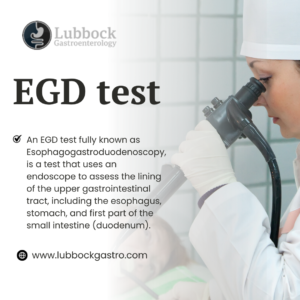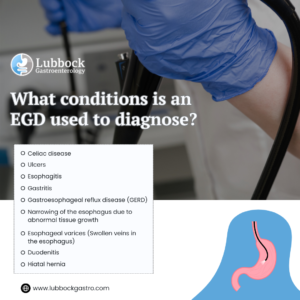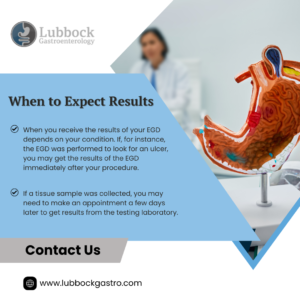EGD test in Lubbock, TX

EGD test in Lubbock, TX
An EGD test in Lubbock, TX, fully known as Esophagogastroduodenoscopy, is a test that uses an endoscope to assess the lining of the upper gastrointestinal tract, including the esophagus, stomach, and first part of the small intestine (duodenum). It has a lot of purposes, and it’s performed at the hospital by a gastroenterologist.
Continue reading this article to learn more about this procedure.
Why an EGD test is performed
An EGD test is performed for the following reasons:
Diagnostic reasons
An EGD test may be required to confirm your diagnosis if you experience specific symptoms, such as severe, chronic heartburn, vomiting blood, black or tarry stools, regurgitating food, pain in your upper abdomen, unexplained anemia, persistent nausea or vomiting, unexplained weight loss, and many others.
It can be used to diagnose ulcers and tumors of the esophagus and stomach. Making the correct diagnosis is essential for getting the appropriate treatment.
Therapeutic purposes
An EGD can also be used to treat specific conditions. The gastroenterologist can attach specialized tools to the endoscope used in EGD to perform treatment such as upper GI bleeding control, removing polyps and tumors, opening constricted pathways, removing foreign objects, placing necessary medical devices for tube feeding, performing laser therapy, or banding oversized or abnormal veins in the esophagus.
To monitor treatment
Another reason why the EGD test is performed is to help see how effectively a treatment works or to track complications you may have gotten following a particular treatment.
EGD can be used to assess the treatment process for conditions such as Crohn’s disease, peptic ulcers, cirrhosis, and swollen veins in the lower esophagus.
What symptoms suggest a person needs EGD?
The following symptoms may be suggestive that you need an EGD:
- Abdominal pain
- Bleeding in the upper gastrointestinal tract.
- Nausea and vomiting.
- Feeling of fullness even after eating smaller portions than you normally would.
- Feeling that food is lodged behind your breastbone
- Chronic heartburn
- Swallowing problems.
- Weight loss.
What conditions is an EGD used to diagnose?

What conditions is an EGD used to diagnose
EGD can be used to diagnose conditions such as:
- Celiac disease
- Esophagitis
- Gastritis
- Gastroesophageal reflux disease (GERD)
- Narrowing of the esophagus due to abnormal tissue growth
- Esophageal varices (Swollen veins in the esophagus)
- Duodenitis
- Hiatal hernia
- Ulcers
Advantages of Opting for an EGD
The benefits of opting for an EGD include the following:
Quick, painless procedure
One of EGD’s leading advantages is its quick and painless. It’s to be handled by a skilled gastroenterologist who can quickly assess the gastrointestinal tract and either use the procedure to confirm a diagnosis, treat a condition, or monitor the progress of a treatment.
It also gives the gastroenterologist a chance to perform corrective procedures during the EGD.
Fast diagnosis
Another benefit of EGD is that it offers a fast method of diagnosing certain medical conditions, and this allows for the immediate treatment of the condition.
Fast diagnosis and treatment offer rapid symptomatic relief for patients. Most times, this procedure offers a more comprehensive diagnostic tool compared to an X-ray
Relatively low-risk procedure
Another thing about EGD is that it’s a safe and relatively minimal-risk procedure. It’s not associated with severe risk.
Possible complications include bleeding and allergic reactions to the sedative agent used during the procedure.
What to Expect and How It’s Performed
An EGD is performed in a hospital or outpatient center. During your appointment, you will be given a sedative to help you stay relaxed and comfortable during the procedure. An intravenous (IV) needle will also be placed in your arm or hand to give you the sedative. Note that in some cases, you may not need a sedative for EGD.
The provider may also give you a liquid medicine or a spray medicine to numb your throat. These medicines work to prevent you from gagging during the procedure.
A mouth guard is then used to protect your teeth and the scope. If you’ve dentures, they will be removed before the procedure starts. You will be positioned to lie on your left side.
The endoscope is then inserted into the gastrointestinal tract through your mouth and runs through to reach the duodenum.
Air is put through to make it easier for the gastroenterologist to assess the area. Biopsies can be taken through the endoscope. Different treatments can be done during the EGD procedure, such as stretching or widening a narrowed esophagus area.
What to Expect After the Test
After the test, the air is suctioned out of your stomach after withdrawing the endoscope. However, some gas may be left there till the next day. Side effects of the procedure include bloating and passing gas (burping and farting). Cold foods and drinks can help soothe your throat following the procedure.
You may not be aware or alert immediately after the test if you were sedated. You may need to remain in the hospital for a while until you are alert enough to be discharged.
You can get the test results immediately after the procedure, but in some cases, especially when biopsies are taken, you may need another appointment to get the results.
Recovery from an EGD
EGD is associated with post-procedure discomfort and requires minimal recovery. The best thing to do after your EGD for good recovery is to rest well. It’s normal to experience bloating, nausea, or cramping and a mild sore throat after EGD.
The only way your body will be able to heal faster is if you let yourself get some rest. Throat lozenges or sprays can also help with the sore throat.
In recovery from an EGD, make sure to drink plenty of fluids. Ensure you drink plenty of water throughout your recovery, even if swallowing hurts. Opt for water and avoid carbonated drinks, which can cause gas and discomfort on an empty stomach.
Once you can swallow normally, you may return to your regular diet. However, after EGD, you may want to avoid certain foods, such as foods high in fat, as they can cause stomach discomfort during recovery.
When to Expect Results

When to Expect Results
When you receive the results of your EGD depends on your condition. If, for instance, the EGD was performed to look for an ulcer, you may get the results of the EGD immediately after your procedure. If a tissue sample was collected, you may need to make an appointment a few days later to get results from the testing laboratory.
Abnormal EGD Test
Abnormal EGD test findings may be a result of celiac disease, which is damage to the lining of the small intestine, Esophageal varices and inflamed or swollen esophagus (esophagitis), or ulcers could be gastric or duodenal, Mallory-Weiss syndrome (tear in the esophagus), narrowing or stricture of the esophagus, tumors or cancer in the esophagus, stomach, or duodenum.
FAQ
Is an EGD test painful?
The EGD test is not painful. It’s uncomfortable, but it’s not painful because a form of anesthesia is administered during the procedure to numb the region.
What is the difference between EGD and endoscopy?
Endoscopy is a medical procedure that uses an endoscope to examine various parts of the esophagus, stomach, upper GI tract, or small bowel. It is divided into two types, namely, upper and lower endoscopy.
The upper endoscopy is the esophagogastroduodenoscopy, which involves using the endoscope to inspect the stomach, the lining of the esophagus, and the first part of the small intestine (duodenum).
How long do EGD results take?
The duration it takes to get an EGD result depends on your condition and the purpose of the EGD. In cases where you only need to confirm ulcers or esophageal narrowing, you can get your results immediately. However, when a biopsy is taken, it may take about two weeks to get the pathology result.
What type of cancers can an EGD detect?
It can be used to detect both esophageal and gastric cancer.
Can you eat generally after EGD?
You won’t be able to eat immediately after an EGD because of difficulty in swallowing following the procedure. After some hours, you can consume a soft and easily digestible diet. Avoid foods that irritate or cause discomfort through your upper gastrointestinal tract.
Will an EGD show liver problems?
An EGD can’t directly show liver problems, but it can show features such as esophageal and dilated veins in your esophagus that happen when you have high blood pressure in the portal vein, which may suggest a liver problem.
How accurate is EGD?
Although the degree of accuracy of EGD varies depending on what it’s used for, it’s still highly accurate across most of its uses.
Can EGD detect gastritis?
Yes, EGD can be used to detect gastritis. It helps to diagnose, determine the cause, and manage complications of gastritis.
Best Clinic to get EGD Test in Lubbock, TX
Whether you need an EGD test for diagnostic or therapeutic purposes, it has to be performed by a skilled and experienced gastroenterologist. Dr. Sameer Islam is the best gastroenterologist in to help you with the EGD Test in Lubbock, Tx.
Dr. Islam’s clinic offers a comprehensive EGD test in Lubbock for an accurate diagnosis and the most appropriate treatment for your condition. It’s one of the best clinics in Lubbock to get upper gastrointestinal endoscopy.
Contact Dr. Islam to learn more about EGD and get the test.
